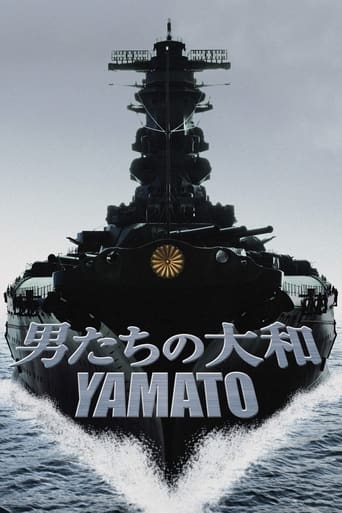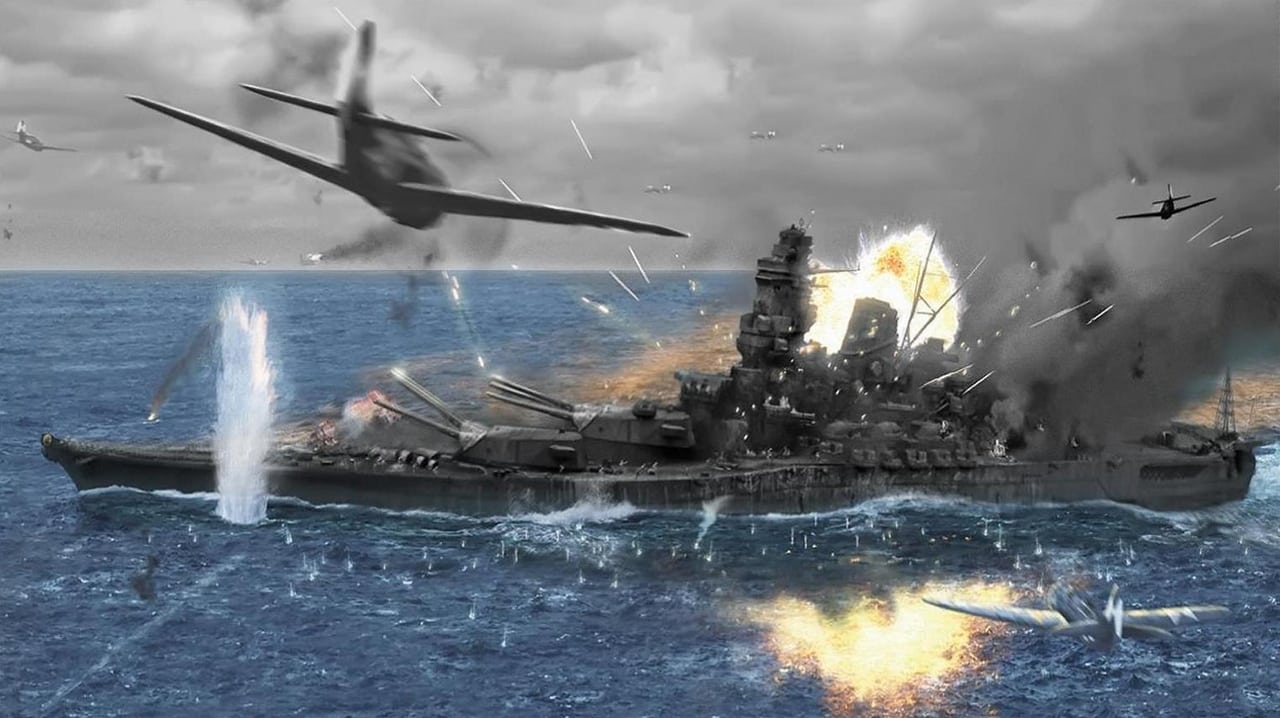PWNYCNY
This is a great movie. It refutes the shallow, stereotypical portrayal of Japanese in World War Two American movies. When considering atrocities such as The Bataan Death March, it is easy to say, "Good for them, they deserved what they got." Yet, the movie is about Japanese valor. The question is: is it contrived or was it real? Here, the roles are reversed. The Japanese are heroes and the Americans the faceless enemy. The Yamato went down fighting; en entire fleet pf plans were required to sink her, and when she sunk, she went out with a huge bang - that is a fact. The movie dramatizes the dedication and bravery of the Japanese sailor and the steadfast valor of the civilians. The movie is not a polemic. It neither excuses or apologizes Japanese policies. Of course, one can say that this movie does not square with the Japanese record of brutality during the war. But that does not mean that the themes of this movie are contrived. The Japanese government ordered the Yamato on a kamikaze mission. Whether this was heroic is a matter of debate. But what is certain is that the ship took a beating and 3,000 crew died, and that is a story that should not be forgotten. They fought and they died. As the movie shows, the Japanese were caught up in a war that produced a catastrophic defeat for them. It is just too bad that they had adopted a foreign policy that in retrospect was misguided and provocative, but it happened and hopefully it will not happen again.A few other comments: This movie alludes to but does not fully expand on how the Yamato was a symbol, not only for the Japanese, but for the United States. While the Yamato symbolized Japanese pride, for the United States it was symbol of aggression, and something that not only had to be destroyed but absolutely purged from the face of the planet. Hence, the United States devoted an entire fleet of planes to ensuring that the Yamato met an ignoble ending. The movie shows that how the Yamato was not only bombed, but was repeatedly strafed and torpedoed. According to historical accounts, the Yamato took at least twenty direct hits. What the movie also brings out was that the Yamato was on a kamikaze mission, so it was provided no air cover, which made it a virtual open target. The Yamato crew are portrayed as being valiant, but valiant for what and for whom? One scene shows where a fight breaks out between two factions, one who questioned the use of fighting and the other that was determined to fight on. However, this theme is not further explored. The whole question of treating 3,000 men as being expendable is a theme that could have been further explored too. The sinking of the Yamato should have provided enough cause for any rational government to conclude that further fighting was useless, but that did not happen. The war destined to drag on for another four months, during which time there took place the Battle of Okinawa and the atomic bombings of Hiroshima and Nagasaki, all of which had catastrophic consequences for the Japanese. The movie also shows how discipline was enforced through corporal punishment, which puts the Japanese abuse of POWs in a broader cultural context. For the Japanese, at least in the military, beating up on people considered inferior was considered appropriate conduct and a legitimate form of discipline. Given the fanaticism of the Japanese military, it is not surprising that it took not one but two atomic bombs to finally convince them to stop fighting, and that was only after the emperor personally interceded. As the movie shows, World War Two was a disaster for Japan, and a tragedy for the Japanese people who had to pay the price for policy decisions that opened their country up to destruction and leaving a legacy that to this day continues to besmirch that country's reputation.
Mark
I guess the ambition of this film is to show the personal drama taking place alongside the big drama of the last ditch demise of the great "Yamato", and from this point of view the film performs well but expectable. There is the tragedy of young lives being lost for a lost cause, the psychological wounds of the survivors that never heals. There's also the mandatory journey to the spot of the disaster made on an anniversary by one of the survivors and a daughter to another, maybe inspired by J. Cameron's "Titanic". Factually, though, the film is a failure. It would of course be impossible to make a replica of the ship, so it has been recreated digitally, and to excellent effect in the few scenes you actually view the whole ship, or most of it, making its way through the seas. Those moments alone are worth the price of the ticket. But the budget didn't cover much more than that. The mock-up of certain parts of the ship look just like mock-up, we don't even get to know about one light cruiser and several destroyers that followed "Yamato" to disaster (most of them were also sunk) and we don't see one single US ship (aircraft from at least 12 American aircraft carriers participated in fending off the Japanese). What's worse, we are not told how the battle developed or what tactics were used by the Japanese task force nor by the US air squadrons. The great battleship was eventually sunk after being hit by many torpedoes and several big, armor-piercing bombs, but most of what we see is low flying US aircraft strafing the crew and hitting the decks with small caliber ordnance, causing incredible carnage. The strafing did take place on several occasions during the day, the ship was also hit by small rockets from F4U Corsair fighters, but it all had marginal effect. The huge 456 mm guns are seen firing away towards the approaching aircraft, and while this in fact did happen, one couldn't stay exposed on deck, as the enormous blast would probably kill or at least severely injure you, so crew were forbidden on the outside on such occasions. All in all, the never-ending screams of dying seamen don't make up for the lack of most of other angles of this last major battle of WWII. All in all, some 3000 Japanese lives were lost on the "Yamato" alone, plus more than a thousand more on the accompanying ships, without disturbing the US Okinawa operations in any way. Some figures are mentioned in the film but the tragedy of this sacrifice in not fully pointed out. During the day the US lost 12 airmen and 10 airplanes.
Enchorde
Recap: Katsumi Kamio is not very old, just 15 years old, but with his nation Japan in war he decides to follow his brother and join the Imperial Navy. He gets posted on the pride of the navy, the world's largest and most modern battleship Yamato. The young recruits are convinced and determine to change the tide of war with the powerful ship or die a glorious death with it. Unfortunately, although the ship is newly built it is hopelessly obsolete without a fighter escort. Kamio, posted as an anti-aircraft gunner sees this firsthand. 60 years later, the daughter of a friend from Yamato comes to Kamio and wants to hire Kamio and his boat to go to the location of the recently rediscovered Yamato. The trip is not only a trip out to ocean but also a trip back in history and Kamio's memories.Comments: This is not a war-movie in that way that it focuses and follows the Yamato into battle and adrenalin-high scenes. No, this is the kind of war-movie that follows Kamio that finds himself on the Yamato and his friends, and the companionship that develops on the ship. The idea that to die a glorious death is foremost in almost everyone's minds, to bring glory to the country, the Navy and your family. To survive is shameful. Those two feelings, those ideas come to a hard collision when Yamato is sent on a final suicide mission to attack the invading American forces. Also the mission, as pointed out in the movie, the mission marks an end to an era, international and Japanese. Yamato was the crown in the line of battleships but hopelessly lost without air support.This is a remembrance and a way to live with the effects of the Second World War. The bombs over Hiroshima and Nagasaki are not mentioned much but those, and all other deaths of the war hangs like a shadow over the movie.Although it is not action-packed (although with a few blood-filled gruesome battles), quite long and the story known it never becomes dull. The companionship and the history of Kamio and his friends are really intriguing. And somehow you feel the weight of the movie, and it is definitely not only for Japanese.6/10
shusei
I will write this review as a researcher of film culture(mainly, Russian, but not only). Apparently,this film is made as a "War Anniversary film". At the same time, it is made as a blockbuster,by which the company TOEI intended to redeem its status of Japanese Major film company(2500 million yen is not at all a normal budget for contemporary Japanese cinema.Kurosawa's "Ran" was made with almost the same budget 20 years ago,when the the situation of the industry was still better, as a co-production with France).In spite of such risky budget,TOEI didn't think of world sales at all. If compare with "Sun(Solntse)" by Alexander Sokurov,from the beginning international product and a "festival film", this risk seems incredible--10 times higher cost and gamble-like dependence on domestic consumption.We must keep in mind that such "War Anniversary films", even in Russia,where the government gives donation to filmmakers maximum to 70% of the budget,with intention of participation in world market and festivals, rarely can be "correct" from political point of view. I'm talking about "SVOI"(2004),which failed to participate in Canne and "Zvezda"(2002),which seems too pathetic and patriotic to be international. Japanese government never donate to any films more than 30% of the budget,which is rather cruel condition for non-Hollywood national films.So the task of director-writer Junya Sato, I think, was very, very difficult. He must have expected the reactions of all generations of Japanese nation,and make the film's "correctness" level as high as possible, not invoking any misunderstanding from any political organizations. And of course,as a veteran craftsman director,his film must have surely return the money to production company.As a results this film is a little eclectic;the story clearly tells the meaninglessness of the huge battleship strategy and meaningless death of many people, but some scenes are accompanied by heroic march,solders and officers seem at first naive militarists, after some time turn into absolutely sincere lovers, sons and brothers, who, in the end clearly know the nonsense of the last attack.The craftsmanship, with which Sato achieved expected results, is worthy of admiration. The idea of the film, and the conditions of its production, from the first didn't guarantee any well-made war film. He made his best, and we can see that the tension in directing is very high.


 AD
AD




